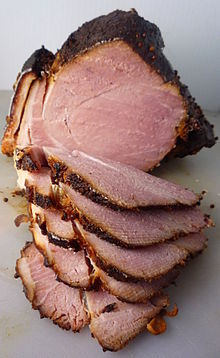Gammon (meat): Difference between revisions
Content deleted Content added
Jeez, next source also doesn't mention gammon, but talks about ham hock, checking if gammon hock exists at all as a concept, hmm, yes, but basically as a synonym -I'll move all the USA stuff to 'ham' shortly |
Next, "glazed gammon" appears to exist in recent British recipes, although Gordon Ramsey for one just calls it glazed ham... but the ref. used (Betty Crocker) refers to USA glazed ham, not gammon, which isn't mentioned -moving all that stuff to 'ham', which (I'll be damned) has an explanation for gammon better than found here. Tag: references removed |
||
| Line 1: | Line 1: | ||
[[File:BBQ Gammon Sliced (4767063533).jpg|thumb|Sliced gammon]] |
[[File:BBQ Gammon Sliced (4767063533).jpg|thumb|Sliced gammon]] |
||
'''Gammon''' is a name for a type of |
'''Gammon''' is a British name for (a type of) [[ham]]. Like other hams, it is the hind leg of [[pork]] after it has been [[curing (food preservation)|cured]] by [[Salting (food)|dry-salting]] or [[brining]],<ref>{{cite web|url=http://www.bbc.co.uk/food/gammon|title=Gammon recipes - BBC Food|website=www.bbc.co.uk}}</ref> and it may or may not be [[Smoking (cooking)|smoked]].<ref name=product>https://wiltshirebacon.com/product-category/gammon/</ref> Unlike most hams, but like [[bacon]], it must be cooked before it is safe to eat.<ref name=product/><ref name="BodeLeto2012">W K H Bode; M J Leto. ''[https://books.google.com/books?id=d7F6PvF23qUC&pg=PA178 The Larder Chef]''. Routledge; 25 June 2012. {{ISBN|978-1-136-35712-1}}. p. 178–.</ref> It may be sold on-the-bone or without bone, or as steaks or slices. The words gammon, ham and bacon are often used interchangeably. |
||
[[Ham hock]], gammon hock, or knuckle, is the foot end of the joint, and contains more [[connective tissue]] and [[sinew]].<ref name="HOUSEKEEPING2009">GOOD HOUSEKEEPING. ''[https://books.google.com/books?id=JTP-jeiTBX0C&pg=PT185 Gh Food Encyclopedia]''. Anova Books; 2009. {{ISBN|978-1-84340-503-0}}. p. 185–.</ref> |
[[Ham hock]], gammon hock, or knuckle, is the foot end of the joint, and contains more [[connective tissue]] and [[sinew]].<ref name="HOUSEKEEPING2009">GOOD HOUSEKEEPING. ''[https://books.google.com/books?id=JTP-jeiTBX0C&pg=PT185 Gh Food Encyclopedia]''. Anova Books; 2009. {{ISBN|978-1-84340-503-0}}. p. 185–.</ref> |
||
In Britain joints of cooked gammon are often served at [[Christmas]] or on [[Boxing Day]]. |
In Britain joints of cooked gammon are often served at [[Christmas]] or on [[Boxing Day]]. |
||
Particularly in the US, "fresh ham" may refer to raw, uncured hind leg of pork.<ref>{{Citation |
|||
| url = http://www.fsis.usda.gov/wps/portal/fsis/topics/food-safety-education/get-answers/food-safety-fact-sheets/meat-preparation/ham-and-food-safety/CT_Index |
|||
| accessdate = 2013-12-28 | title = Ham and Food Safety | publisher = USDA |
|||
}}</ref><ref name="Sinclair1998">Charles Gordon Sinclair. ''[https://books.google.com/books?id=fnveo8cyxKkC&pg=PA252 International Dictionary of Food and Cooking]''. Taylor & Francis; January 1998. {{ISBN|978-1-57958-057-5}}. p. 252–.</ref> |
|||
Glazed gammon, or glazed ham in the US, is coated with a flavoured or spiced sugar solution before cooking. This [[caramelization|caramelizes]] during cooking and also gives a distinctive appearance. This may be enhanced by scoring the skin in a diamond pattern beforehand, or by sticking the joint with [[clove]]s.<ref >{{Cite web |
|||
|title=10 Ridiculously Easy Ham Glaze Recipes |
|||
|website=[[Betty Crocker]] |
|||
|url=https://www.bettycrocker.com/how-to/tipslibrary/cooking-tips/ham-glazes |
|||
}}</ref> |
|||
The word "gammon" is related to the French word ''[[wikt:jambon#French|jambon]]'', meaning "ham", which in turn is derived from [[Late Latin]] ''[[wikt:gamba#Latin|gamba]]'', meaning "leg".<ref>{{cite web|url=http://www.etymonline.com/index.php?term=gammon|title=gammon - Origin and meaning of gammon by Online Etymology Dictionary|website=www.etymonline.com}}</ref>. |
The word "gammon" is related to the French word ''[[wikt:jambon#French|jambon]]'', meaning "ham", which in turn is derived from [[Late Latin]] ''[[wikt:gamba#Latin|gamba]]'', meaning "leg".<ref>{{cite web|url=http://www.etymonline.com/index.php?term=gammon|title=gammon - Origin and meaning of gammon by Online Etymology Dictionary|website=www.etymonline.com}}</ref>. |
||
Revision as of 01:31, 19 November 2018

Gammon is a British name for (a type of) ham. Like other hams, it is the hind leg of pork after it has been cured by dry-salting or brining,[1] and it may or may not be smoked.[2] Unlike most hams, but like bacon, it must be cooked before it is safe to eat.[2][3] It may be sold on-the-bone or without bone, or as steaks or slices. The words gammon, ham and bacon are often used interchangeably.
Ham hock, gammon hock, or knuckle, is the foot end of the joint, and contains more connective tissue and sinew.[4]
In Britain joints of cooked gammon are often served at Christmas or on Boxing Day.
The word "gammon" is related to the French word jambon, meaning "ham", which in turn is derived from Late Latin gamba, meaning "leg".[5].
See also
References
- ^ "Gammon recipes - BBC Food". www.bbc.co.uk.
- ^ a b https://wiltshirebacon.com/product-category/gammon/
- ^ W K H Bode; M J Leto. The Larder Chef. Routledge; 25 June 2012. ISBN 978-1-136-35712-1. p. 178–.
- ^ GOOD HOUSEKEEPING. Gh Food Encyclopedia. Anova Books; 2009. ISBN 978-1-84340-503-0. p. 185–.
- ^ "gammon - Origin and meaning of gammon by Online Etymology Dictionary". www.etymonline.com.




